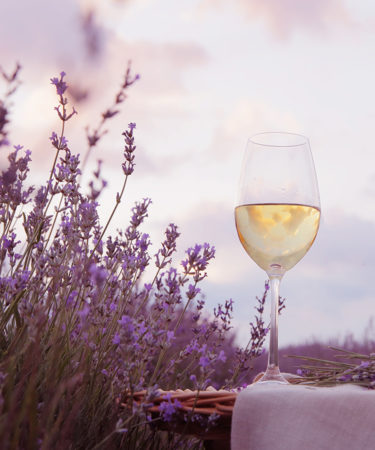
Around the start of spring, bottles of rosé start appearing in wine retailers—and boxes, too—like little soldiers ready for a season of barbecues. Rosé is delicious, yes, but if you only drink the pink stuff from now until the end of warm weather, you might quickly get bored of wine altogether.
Fortunately, rosé is far from your only choice for light, refreshing, interesting wine in the springtime. Get to know some of these wines and try them next time you’re lusting after just the right bottle for these sunny days and breezy nights.
Affordable, But Elegant, High-Toned White Wines:
I’m about to tell you about one of the best kept wine secrets out there: Muscadet. Not to be confused with the similar-sounding Italian Moscato, this is a dry white wine from the Loire Valley of France that delivers insane quality for the price. “Muscadet” is thought to be a nickname of sorts for this wine, made of 100 percent Melon de Bourgogne. The Muscadet region is right along the Atlantic coast, and it literally seems like you can taste the salty air when you sip a bright, mineral Muscadet. But these wines have body, too, thanks to the local practice of aging the juice on its “lees,” comprised of the dead yeasts and grape skins. Lees-aging adds creaminess and complexity to a wine that’s already packed with peach and apricot flavors. Muscadet is the traditional pairing for oysters, and it’s great with all kinds of seafood.
Another unbelievable value is Vinho Verde, a low-alcohol white wine from northern Portugal meant to be drunk young. Because it is bottled early, a tiny bit of fermentation continues in the bottle, and a slight fizz develops, making this wine incredibly refreshing on a patio with some chips and salsa. Some Vinho Verde wines are artificially carbonated, but the traditional ones let the effervescence occur naturally. Vinho Verde is an example of what’s called a “cheap and cheerful” wine—could you ask for anything better, for spring?
Try:
Light French Reds:
Beyond the well-known regions of Bordeaux and Burgundy, you can find some really fresh, light, and guzzle-able red wines all over France. With low tannins and usually no oak aging, these reds are perfect in spring and summer, and it’s even ideal to serve them after 20-30 minutes in the fridge.
In Beaujolais, red wine is made from the Gamay grape, which is high in acidity, earthy, and delicious with roast chicken. There are 10 “crus” in Beaujolais, meaning special sites marked for their superior terroir, and wines from these sites can age quite well. The Loire Valley of Northwest France makes red wines in the “glou glou” style, meaning deliberately low-alcohol, fresh, and easy to drink; the native grape Pineau d’Aunis is often made in this style and it benefits from being naturally high in acidity as well. And in Eastern France, the region of the Jura produces light reds made from Trousseau and Poulsard, as well as Pinot Noir. Enjoy one of these light French reds at your next BBQ.
Try:
- Marcel Lapierre “Raisins Gauloises” $13
- Brendan Tracey Pineau d’Aunis $23
- Domaine de la Tournelle “La Uva Arboisiana” Poulsard $26
Italian Lambrusco:
Somewhere along the way, Lambrusco got a bad rap, and people began to see it as a sickly-sweet beverage for not-serious drinkers. I’m sure there is some bad Lambrusco out there, but it’s possible to find great bottles of this light red, fizzy wine from Emilia-Romagna, and you will be delighted at how refreshing, savory, and food-friendly the wines are. Lambrusco is actually the name of the grape that makes this light red wine. Ask your retailer for a dry one, and you’ll discover that it’s amazing when served chilled, with pizza or charcuterie. It’s amazing to pour yourself a glass of bubbly Lambrusco at the end of the day, while catching the last few minutes of sunlight on your patio.
Try:
Georgian Orange Wines:
You know when you’re not quite sure if you’re in the mood for white, or red? There’s a wine for that. It’s called amber or orange wine, depending on who you ask, but it’s not made from oranges. Once you try it, you’ll see why it’s perfect for the early days of spring.
Orange wine is made from white grapes that have been left to macerate on their skins. It sounds very technical, but basically all you have to know is that, typically, white wine is made by separating juice from skins right away. So, if you leave the juice in contact with the skins, the wine inherits some tannin and structure, and savory notes. It’s a winemaking technique that has long been traditional in the country of Georgia, and although orange wines are now appearing everywhere from Italy to New York, the Georgian wines are excellent examples of this style. The one shown below is made from the grape Rkatsiteli—pronounced [REH-KAH-SIT-EL-EE] if you want to impress your friends.
Try:
